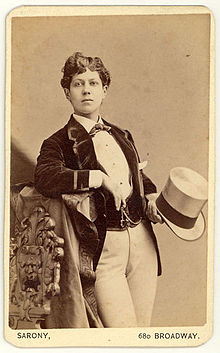Ella Wesner
Ella Wesner | |
|---|---|
 Wesner in a carte de visite by Napoleon Sarony, c. 1872-75 | |
| Born | May 29, 1841 New Jersey, U.S. |
| Died | November 10, 1917 The Bronx, New York, U.S. |
| Occupation | Vaudeville performer |
Ella Wesner (May 29, 1841 – November 10, 1917) was a celebrated male impersonator of the Gilded Age vaudeville circuit.
Early life and education
Ella (or Ellen) Wesner was born in New Jersey and raised in Philadelphia, Pennsylvania, the child of Charles H. Wesner and Evalina (or Emeline) Wesner. She began her career at the age of nine as part of a family of vaudeville and musical-stage dancers. She was half of the Wesner Sisters with her sister Mary.[1]
Career
By her mid-twenties, Wesner was playing both male and female roles, at some point meeting and working as a "dresser" for a popular vaudeville male impersonator of the time, Annie Hindle. She developed her own impersonator act based on Hindle's,[2][3][4] as a "swaggering, cigar-smoking, swearing" young man.[5] Hindle and Wesner worked together on the vaudeville circuit, and sang some of the same songs,[6] both using a husky, contralto voice for their performances.[7][8]
Wesner's career was also closely linked to the vaudeville impresario Tony Pastor, for whom she was the featured male impersonator, performing at Pastor's theater and touring in traveling shows he organized.[9]
Wesner's career was briefly derailed in 1873 when she abruptly left Pastor's shows to elope to Paris with the notorious Helen Josephine "Josie" Mansfield,[10] who had been the mistress of Gilded Age robber baron "Diamond Jubilee" Jim Fisk as well as the mistress of his murderer, Edward S. Stokes. The event evoked considerable scandal; it was discussed in most of the major metropolitan newspapers and journals in New York, Chicago, and other major American cities. After the romance cooled, however, Wesner returned to the United States and resumed her career with Pastor, winning even wider audiences.[9] She performed in London concert halls in 1877.[11]

In the 1880s, Wesner's act included not only songs celebrating the "sporting" life and skits such as her popular rendition of a drunkard getting a barber's shave, but also monologues containing advice for men about how to court, treat and satisfy women.[2][12] She also sang songs to promote certain brands of alcohol and tobacco; that she was drawing extra income from these advertisements outraged the orchestra involved.[13] Wesner's career stumbled as styles changed; she shifted routines to become a "quick-change" artist, and eventually faded from vaudeville.[14] Impersonator and singer Ella Shields credited Ella Wesner as an inspiration.[15]
Death
Wesner died in the Bronx in 1917, at the age of 76. By her request, her body was dressed in a menswear suit for burial.[16] Her grave is in the Actors' Fund Plot, Prospect Hill at Evergreens Cemetery, in Brooklyn, New York.[1]
References
- ^ a b "Ella Wesner Dies". The Brooklyn Daily Eagle. 1917-11-12. p. 20. Retrieved 2023-06-02 – via Newspapers.com.
- ^ a b Gillian Rodger, " He Isn't a Marrying Man: Gender and Sexuality in the Repertoire of Male Impersonators, 1870-1930," in Sophie Fuller, Lloyd Whitesell, eds. Queer Episodes in Music and Modern Identity (Urbana, IL: University of Illinois Press, 2002) pp. 109-110.
- ^ Rodger, Gillian M. (2010-06-17). Champagne Charlie and Pretty Jemima: Variety Theater in the Nineteenth Century. University of Illinois Press. ISBN 978-0-252-07734-0.
- ^ Harbin, Billy J.; Marra, Kim; Schanke, Robert A. (2005). The Gay & Lesbian Theatrical Legacy: A Biographical Dictionary of Major Figures in American Stage History in the Pre-Stonewall Era. University of Michigan Press. pp. 374–375. ISBN 978-0-472-06858-6.
- ^ Bullough, Vern L.; Bullough, Bonnie (1993). Cross Dressing, Sex, and Gender. University of Pennsylvania Press. p. 228. ISBN 978-0-8122-1431-4.
- ^ Barz, Gregory; Cheng, William (2019-09-23). Queering the Field: Sounding Out Ethnomusicology. Oxford University Press. p. 85. ISBN 978-0-19-045804-1.
- ^ Walker, Jessica (2012-03-28). "The Girl I Left Behind Me: The disjunction between vocal and visual performance in male impersonation". Studies in Musical Theatre. 6 (1): 99–113. doi:10.1386/smt.6.1.99_1. ISSN 1750-3159.
- ^ Rodger, Gillian M. (March 2015). "When Singing Was Acting: Song and Character in Variety Theater". The Musical Quarterly. 98 (1–2): 57–80. doi:10.1093/musqtl/gdv006. ISSN 0027-4631.
- ^ a b Rodger, Gillian M. (2018-01-04). Just One of the Boys: Female-to-Male Cross-Dressing on the American Variety Stage. University of Illinois Press. ISBN 978-0-252-05016-9.
- ^ Faderman, Lillian; Timmons, Stuart (2009-08-03). Gay L.A.: A History of Sexual Outlaws, Power Politics, and Lipstick Lesbians. Univ of California Press. pp. 17–18. ISBN 978-0-520-26061-0.
- ^ "Miss Ella Wesner (advertisement)". The Era. 1877-06-10. p. 20. Retrieved 2023-06-02 – via Newspapers.com.
- ^ Laurence Senelick, The Changing Room: Sex, Drag and Theatre-- Gender in Performance (London: Routledge, 2000), pp.307-308, 331
- ^ "Ella Wesner's Voice; It is Matched Against an Orchestra and Wins the Race". Chicago Tribune. 1885-05-17. p. 14. Retrieved 2023-06-02 – via Newspapers.com.
- ^ "Made Happy the Days When Life was Young". Times Union. 1901-11-11. p. 2. Retrieved 2023-06-02 – via Newspapers.com.
- ^ Fuller, Sophie; Whitesell, Lloyd (2002). Queer Episodes in Music and Modern Identity. University of Illinois Press. pp. 127–128. ISBN 978-0-252-02740-6.
- ^ "Ella Wesner Lies in Man's Garb". The New York Times. 1917-11-14. ISSN 0362-4331. Retrieved 2023-06-02.
External links
- Ella Wesner memorabilia page, with several publicity photos and posters, at Queer Music Heritage
- Four photos of Ella Wesner in the Billy Rose Theatre Collection, New York Public Library